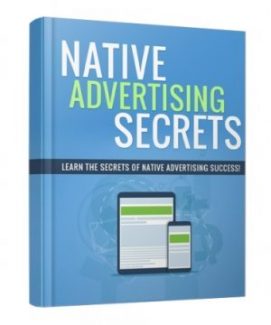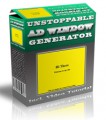 License Type: Personal Use
License Type: Personal Use  File Type: ZIP
File Type: ZIP
 SKU: 59551
SKU: 59551  Shipping: Online Download
Shipping: Online Download
Ebook Sample Content Preview:
Introduction
Native Advertising may sound foreign to you, but believe me; you will want to know all there is to know about this powerful new traffic-generating strategy. Not only is this one of the easiest ways to send a swarm of high-quality traffic to your websites, but it’s one of the hottest new methods online. And don’t worry, native advertising is an ‘evergreen’ strategy that is bound to be accepted by publishers for many years to come. As you’ll soon discover, it’s quickly becoming known as THE leader in advertising models.
In fact, in 2016, 3 out of 4 publishers offer some form of native advertising on their websites, with over 90% of publishers planning to launch native advertising this coming year!
So let’s break it down for you, nice and easy, shall we?
Do you remember the popular traffic generation strategy back in early 2010 that was called “content marketing”? Well, native advertising is even hotter, and easier than content marketing, though it’s based on the same idea.
You see, native advertising based campaigns will send your click-through rates through the roof because not only are they highly targeted, but they are designed to look like killer content rather than traditional ads. Hence the word ‘native’. Your content will look and feel like the platform that it’s being hosted on.
What does that mean to you?
It means that your ads will blend into the platforms in which you are being featured, giving users a positive experience, and encouraging engagement with website visitors who are there to consume content! Most often, your visitors won’t even realize that they are advertisements at all, increasing interaction and making it easy for you to build brand awareness.
Quite often, native advertising is created in such a way as to disguise the fact that it’s an ad at all, and instead, is designed to look like an article, news, or blog posts. One example would be a native ad campaign set up as a lead page in order to generate and collect subscribers or leads, but is made to resemble a high quality article, relevant to the niche you are targeting.
A traditional landing or squeeze page usually includes a headline, an opt-in form and a few bullet points outlining what the person will receive after subscribing to a newsletter, and the call to action. There isn’t a lot of content or value that is visible upfront.
A “Native Advertising” ad is totally different. It offers exceptional value in some form of engaging content, and the landing page that visitors may end up on will deliver on that promise.
How do you get started with native advertising, and build highly effective marketing campaigns that will generate maximum traffic and increase sales?
Let’s begin with understanding the top 3 ways of building incredibly powerful native advertising based campaigns.
The Top 3 Strategies
There are many different ways to incorporate your advertising message into native advertising campaigns, but here are the three major types of native ads that you are likely to encounter.
Sponsored Content
The most effective type of sponsored content is when you cleverly design ads that are meant to educate and inform, rather than directly sell. In turn, you are maximizing brand exposure, and consistently building brand recognition (which will automatically increase sales). Sponsored content doesn’t look like your typical advertising, at least not to the average visitor, or reader. If done correctly, your sponsored ad will blend in with the existing website content, providing real value to its readers, while giving them an authentic, and positive user experience.
Many people think of sponsored content as just blog posts or articles. In reality, sponsored content could also include Pinterest posts, Native Advertising Secrets Instagram posts, YouTube videos, or even BuzzFeed listicles (list articles).
One of the most important elements of a successful sponsored content ad is to make sure that it is created so that it feels natural on the platform that it’s being featured on. For example, if you plan to create a native ad based sponsored content piece on YouTube, you will want your video to look and feel similarly to those already featured on the channel, focusing on the same target audience, particularly that of the main feed.
And while sponsored content falls under the same marketing umbrella as native advertising, they are a bit different in the fact that sponsored content slots offered by publishers are typically less restrictive than authentic native advertisements. With sponsored content you aren’t always required to use the same font or style as the blog or website that your campaign is being featured on, but we highly recommend that you do anyway. Native ads always look and feel like the host website which in turn will feel far more authentic to website visitors.
Remember, customers will always trust editorial based content over advertising. If you can create your campaign to look and feel natural to Native Advertising Secrets the audience who is familiar with the host website, you will see much better results. I’ll show you a few examples of highly successful native ads that use this very format in an upcoming chapter so you can see for yourself just how easy they are to build, and how incredibly effective they are.
Tip: When considering sponsored content opportunities, don’t overlook the popularity of microblogging websites such as Instagram, Pinterest and twitter. Instagram has over 500 million users on their platform, and offer sponsored content spots throughout their website. Image based websites work particularly well for infographics, recipes, and cartoon-based campaigns.
SnapChat is also making it easier to set up sponsored content advertisements with their new “Memories” platform that allows users to save video clips into custom streams (similar to the way someone would create a playlist on iTunes.)
Recommended Content With recommended content, your brand appears as a recommended resource by prominent websites and networks online, including content discovery networks (more on that in the next chapter).
Publishing networks make money by offering campaigns that typically run on a PPC model. These ads are embedded into the content or theme in some way as to provide a more authentic experience for readers, and quite often will look exactly like other areas of the website such as navigation menus, or other internal links so that readers don’t see them as advertisements at all.
Social Ads This method of advertising on in-feed social ad networks is one of the easiest places to start if you’re new to native advertising. In-feed ads are those you’ll find on places like your Facebook News Feed, where box-type advertisements will be shown right along with updates from friends and family. In-feed social ads don’t always include a call to action within the ad itself, but instead will direct people to a landing page or product information page where you can capture the lead. You can also find in-feed social ads on Linkedin, Twitter, YouTube and Pinterest. Ever see those YouTube videos that you can skip after 5 or 10 seconds? Those are in-feed ads!
The Quick Start Method
Do you know what the easiest method is for creating a high converting landing page for your native ads?
Create a high quality blog post!
Start by deciding on the topic you want to write about. Then, create (or outsource) a killer content piece that is ultra-focused on your market. Make sure it’s informative, entertaining or fun (or all of the above!). Your content doesn’t have to just be textual. Perhaps you have video content you can implement into the blog post, or you have a PowerPoint presentation that you’d like to feature. Whatever you choose, make sure that it provides exceptional value to your target audience, and is relevant to a product or service you are interested in promoting.
If you want to guarantee that it’s a hit, use content from any other platform that you are on that has yielded results. Have you had a newsletter perform better than usual? Have you ever ran an ad campaign on Facebook that yielded incredible results? Analyze your most recent successes, and create a blog post based on that material.
Just remember:
Provide exceptional value. Don’t be afraid to over-deliver on content. Give your best advice, your insider strategy, your best tip.
Make sure its relevant and targeted. You should know your audience better than anyone. Make sure your native-ad landing page provides the kind of information they are hungry for.
Call to Action. Don’t forget to motivate visitors and remind them of the value in subscribing to your newsletter or mailing list. Weave your CTA within your content, adding it once more for a strong finish. This high quality material will form the basis of your landing page. This is where your native advertisements will bring visitors.
Make sure you implement a strong call to action into the post. This includes an opt-in form where visitors can sign up to your newsletter, and you can collect leads. Add more content after the opt-in form, ensuring that you over-deliver on killer content. For best results, weave your call to action into your content, ending your blog post with a secondary call to action. Make it feel as authentic and natural as possible. More content than calls to action!
Once you have a high quality landing page, it’s time to use In-feed social sites to generate exposure and get that traffic pouring in! The easiest way is to post on your Facebook page. Include the same headline that appears on your blog post, enough content to capture attention and keep visitors engaged, and then a photo or image that is relevant to your landing page (make it as interesting and evocative as possible!).
Feel free to expand on your content, adding in an extra punch to your ad, giving readers no choice but to click-through.
When you’re happy with your ad, it’s time to boost it! Just click the “Boost Post” button beneath your ad, and set your budget. I would recommend starting low (maybe $5-10 to begin), and go from there. You can always tweak your ad as you go, utilizing Facebook’s self-serve advertising tools to keep a pulse on activity.








